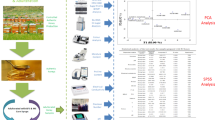Abstract
The suitability of various nectar and honeydew sugars as a food source for the polyphagous ant species M. rubra (L.) was studied. The sugars used included monosaccharides (fructose, glucose, galactose, mannose, rhamnose), disaccharides (sucrose, maltose, trehalose, melibiose, lactose) and trisaccharides (melizitose, raffinose, erlose). Single-sugar solutions were tested on ant workers in a long-term laboratory bioassay in which acceptance of the solutions and ant survival were recorded. The acceptance of the sugars was confirmed in a second bioassay in which feeding time was established. Enzymatic hydrolysis of sucrose, maltose and melibiose was investigated through HPLC analyses of workers fed these disaccharides. Sugar acceptance and feeding time were related to ant survival. Considering the monosaccharide units of which the sugars are composed, fructose seems especially suitable as a short-term energy source, while glucose appears to be used both directly and for storage. The presence of a galactose unit appears to reduce sugar suitability. It is suggested that the workers possess invertase and maltase and to a lesser degree also galactosidase. The gustatory perception is correlated with the profitability of sugars in further metabolic processes.




Similar content being viewed by others
References
Ayre GL (1967) The relationship between food and digestive enzymes in five species of ants (Hymenoptera: Formicidae). Can Entomol 99:408–411
Baker HG, Baker I (1973) Amino acids in nectar and their evolutionary significance. Nature 241:543–545
Bentley BL (1977) Extrafloral nectaries and protection by pugnacious bodyguards. Annu Rev Ecol Syst 8:407–427
Buckley RC (1982) Ant-plant interactions: a world review. In: Buckley RC (ed) Ant-plant interactions in Australia. Junk, The Hague, pp 111–162
Cammaerts M-C (1989) Études chimiques, éthologiques et physiologiques de sociétés de fourmis (Myrmica spp., Manica rubida). Thèse d'agrégation. Université Libre de Bruxelles, Brussels
Candy DJ (1985) Intermediary metabolism. In: Kerkut GA, Gilbert LI (eds) Comprehensive insect physiology, biochemistry and pharmacology, vol 10. Biochemistry. Pergamon, Oxford, pp 1–41
Cornelius ML, Grace JK, Yates JR (1996) Acceptability of different sugars and oils to three tropical ant species (Hymen., Formicidae). Anz Schädl Pflanz Umweltsch 69:41–43
Duncan FD, Lighton JRB (1994) The burden within: the energy cost of load carriage in the honeypot ant, Myrmecocystus. Physiol Zool 67:190–203
Evans DR (1963) Chemical structure and stimulation by carbohydrates. In: Zotter IY (ed) Olfaction and taste I. Pergamon, Oxford, pp 165–192
Ferreira C, Torres BB, Terra WR (1998) Substrate specificities of midgut beta-glycosidases from insects of different orders. Comp Biochem Physiol 119B:219–225
Fiedler K, Hölldobler B, Seufert P (1996) Butterflies and ants: the communicative domain. Experientia 52:14–24
Frisch K von (1934) Über den Geschmackssinn der Biene. Ein Beitrag zur vergleichenden Physiologie des Geschmacks. Z Vergl Physiol 21:1–45
Hölldobler B, Wilson EO (1990) The ants. Springer, Berlin Heidelberg New York
Josens RB, Farina WM, Roces F (1998) Nectar feeding by the ant Camponotus mus: intake rate and crop filling as a function of sucrose concentration. J Insect Physiol 44:579–585
Koptur S (1992) Extrafloral nectary-mediated interactions between insects and plants. In: Bernays E (ed) Insect-plant interactions. CRC, Boca Raton, Fla., pp 81–129
Koptur S, Truong N (1998) Facultative ant-plant interactions: nectar sugar preferences of introduced pest ant species in South Florida. Biotropica 30:179–189
Kunkel H, Kloft W (1977) Fortschritte auf dem Gebiet der Haunigtau-Forschung. Apidologie 8:369–391
Lanza J, Vargo EL, Pulim S, Chang YZ (1993) Preferences of the fire ants Solenopsis invicta and S. geminata (Hymenoptera: Formicidae) for amino acids and sugar components of extrafloral nectars. Environ Entomol 22:411–417
Mullins DE (1985) Chemistry and physiology of the hemolymph. In: Kerkut GA, Gilbert LI (eds) Comprehensive insect physiology, biochemistry and pharmacology, vol 3. Biochemistry. Pergamon, Oxford, pp 355–400
Ricks BL, Vinson SB (1970) Feeding acceptability of certain insects and various water-soluble compounds to two varities of the imported fire ant. J Econ Entomol 63:145–148
Ricks BL, Vinson SB (1972) Digestive enzymes of the imported fire ant, Solenopsis richteri (Hymenoptera: Formicidae). Entomol Exp Appl 15:329–334
Schmidt A (1938) Geschmacksphysiologische Untersuchungen an Ameisen. Z Vergl Physiol 25:351–378
Seifert B (1996) Ameisen: beobachten, bestimmen. Naturbuch
Shimada I, Isono K (1978) The specific receptor for aliphatic carboxylate anion in the labellar sugar receptor of the fleshfly. J Insect Physiol 24:807–811
Shimada I, Shiraishi A, Kijima, H, Morita H (1974) Separation of two receptor sites in a single labellar sugar receptor of the fleshfly by treatment with p-chloromercuribenzoate. J Insect Physiol 20:605–621
Völkl W, Woodring J, Fischer M, Lorenz MW, Hoffmann KH (1999) Ant-aphid mutualisms: the impact of honeydew production and honeydew sugar composition on ant preferences. Oecologia 118:483–491
Wäckers FL (1999) Gustatory response by the hymenopteran parasitoid Cotesia glomerata to a range of nectar and honeydew sugars. J Chem Ecol 25:2863–2877
Wäckers FL (2000) Do oligosaccharides reduce the suitability of honeydew for predators and parasitoids? A further facet to the function of insect-synthesized honeydew sugars. Oikos 90:197–202
Wäckers FL (2001) A comparison of nectar- and honeydew sugars with respect to their utilization by the hymenopteran parasitoids Cotesia glomerata. J Insect Physiol 47:1077–1084
Wada A, Isobe Y, Yamaguchi S, Yamaoka R, Ozaki M (2001) Taste-enhancing effects of glycine on the sweetness of glucose: a gustatory aspect of symbiosis between the ant, Camponotus japonicus, and the larvae of the lycaenid butterfly, Niphanda fusca. Chem Senses 26:983–992
Weil J-H (1978) Biochimie générale. Masson, Paris
Ziegler H, Penth S (1977) Zur Kenntnis der Zusammensetzung des Honigstaues. Apidologie 8:419–426
Acknowledgements
Bioassays were performed partly in the laboratory of Monika Hilker (Angewandte Zoologie / Ökologie der Tiere, Freie Universität Berlin, Germany) to whom J.L.B. is indebted. We thank Roel Wagenaar for his technical assistance during HPLC, Gerrit Meijer for his statistical assistance, Flavio Roces, Jörg Romeis, Claire Detrain and an anonymous referee for their critical and constructive comments on the manuscript, and Ann-Marie Michel for correcting the English.
Author information
Authors and Affiliations
Corresponding author
Rights and permissions
About this article
Cite this article
Boevé, JL., Wäckers, F.L. Gustatory perception and metabolic utilization of sugars by Myrmica rubra ant workers. Oecologia 136, 508–514 (2003). https://doi.org/10.1007/s00442-003-1249-9
Received:
Accepted:
Published:
Issue Date:
DOI: https://doi.org/10.1007/s00442-003-1249-9




